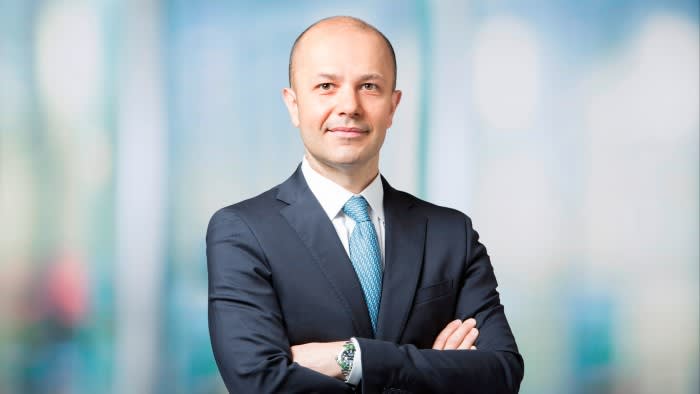Latest news on ETFs
Visit our ETF Hub to find out more and to explore our in-depth data and comparison tools
State Street Global Advisors may have filed the first application to launch an exchange traded fund that would invest in illiquid, hard-to-value private assets, but Matteo Andreetto is focused on faster ETF growth elsewhere.
SSGA’s head of intermediary client coverage, Europe, said ETFs are poised to disrupt the lucrative structured products industry globally, while rolling out ranges of branded funds for big wealth managers is “top of my agenda”.
Andreetto’s insights point to the potential next conquests for the burgeoning ETF industry, which has quintupled in size over the past decade to $14tn, undermining the once all-powerful mutual fund industry in the process.
“ETFs are the most powerful innovation in financial services for the last 20-30 years. There is nothing that has been as disruptive as that,” said Andreetto, a 28-year industry veteran who also spent five years as head of SSGA’s SPDR ETF business in the Emea region.
He is now increasingly focusing on the market for structured products — pre-packaged investments that use derivatives to attempt to achieve goals such as income generation or principal protection — which have been criticised for their complexity, opacity, illiquidity, high fees and counterparty risk.
They are typically issued by banks such as Barclays and JPMorgan and Andreetto puts annual issuance at $60bn-$80bn a year in each of the US and Europe.
The ETF industry has already landed a blow on the structured product market in the shape of buffered ETFs, which use derivatives to provide downside protection and have amassed $35bn in the US alone, according to data from VettaFi.
Covered call, or buy/write ETFs, which sell some upside potential in return for income, have garnered more still.
However, Andreetto believed the ETF industry was “only scratching the surface”.
“There is very little that is in a structured note that can’t be packaged in an ETF. That is the next wave in terms of disruption. It’s a very opaque market. It’s a big market,” he said.
Usurping structured products may not be plain sailing, though. In Europe, for example, there are limits on the use of derivatives in the popular Ucits fund structure used by most ETFs, Andreetto said.
Perhaps more importantly, structured products “have very high selling incentives linked to them”, he said, with intermediaries financially rewarded for selling them, whereas ETFs do not offer such payments.
Another potential avenue of growth is creating ETFs in concert with the wealth management arms of large banks, which control fund distribution in much of Europe.
“In Europe now I see big wealth managers that want to have their own ETF line-up. They don’t have the infrastructure but they want to have the products,” Andreetto said.
His proposed solution is that SSGA designs customised ETFs, which are then branded as being the wealth manager’s.
“I think that’s going to be a massive trend in Europe. It’s top of my agenda in terms of things we are looking at,” he said.
To some extent, the initiatives may be seen as an attempt to counteract SSGA’s declining market share in an ETF industry it largely created in the first place.
Over the past five years its market share has ticked down from 12.7 per cent to 11.5 per cent (even as its assets have more than doubled to $1.5tn), according to data from Morningstar. Over this time, industry leader BlackRock’s iShares’ share has fallen faster, from 36.7 per cent to 31.3 per cent, but Vanguard has forged ahead and more competitors have entered the market.
State Street is fizzing with initiatives to fight back.
Late last year SSGA slashed the total expense ratio for its Ireland-domiciled SPDR S&P 500 Ucits ETF from 0.09 per cent to 0.03 per cent, rendering it the cheapest such vehicle in Europe and less than a third of the price of its $574bn flagship SPDR S&P 500 ETF Trust (SPY) in the US.
Since the cut, the ETF’s market share of net new money flowing into all Ucits S&P 500 ETFs has jumped from sub-5 per cent to 40 per cent, Andreetto said.
Then earlier this month it debuted two ETFs in the US, the SPDR Galaxy Digital Asset Ecosystem ETF (DECO) and a less volatile hedged variant (HECO), which it claims are the first to include both cryptocurrencies (via ETFs and futures) and equities.
Most interest will be focused on SSGA’s groundbreaking proposal to launch an ETF that would invest in private, as well as public credit, in conjunction with Apollo Global Management, however.
The burgeoning private asset market is seen by many as the largest remaining greenfield space for the ETF industry — if concerns around illiquidity and pricing can be resolved to the satisfaction of regulators and investors.
Under the SSGA/Apollo plan, Apollo would step in to provide “firm bids” for any of the private credit that the ETF would need to offload in the event of significant redemptions.
“The liquidity will always be provided by Apollo,” said Andreetto. “I think the solution is credible and robust.”
One potential concern pertains to the risk of “adverse selection”, with Apollo or any other lender having an incentive to retain the best quality credits it originates for its own (performance fee charging) funds, leaving lesser quality credits for the ETF.
Andreetto suggested that would not happen. “Wouldn’t that be detrimental to Apollo’s reputation to do that?” he asked.
As for what determines the price at which Apollo would buy, he was unwilling to be drawn, however, merely noting that “there are things that aren’t fully disclosed as yet”.
Whether this ETF is approved or not, such relationships appear to be increasingly the direction of travel for SSGA.
“We don’t necessarily have [all] the investment exposures. We partner up with other players,” Andreetto said. “The way we see our mission is to provide the tools for the end investors. The future starts here.”
https://www.ft.com/content/6806d1e6-55db-4c27-9a0b-3028bfe27d5c


